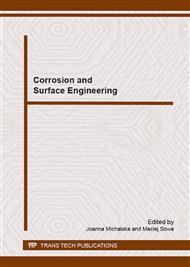[1]
M. Zubielewicz, A. Królikowska, The influence of aging of epoxy coatings on adhesion of polyurethane topcoats and protective properties of coating systems, Prog. Org. Coat. 66 (2009) 129–136.
DOI: 10.1016/j.porgcoat.2009.06.014
Google Scholar
[2]
F. Mansfeld, Use of electrochemical impedance spectroscopy for the study of corrosion protection by polymer coatings, J. Appl. Electrochem. 25 (1995) 187–202.
DOI: 10.1007/bf00262955
Google Scholar
[3]
J.A. Gonzales, E. Otero, A. Bautista, M. Morcilo, Use of electrochemical impedance spectroscopy for studying corrosion at overlapped joints, Prog. Org. Coat. 33 (1998) 61–67.
DOI: 10.1016/s0300-9440(98)00009-5
Google Scholar
[4]
L.S. Hernandez, B. Del Amo, R. Romagnoli, Accelerated and EIS tests for anticorrosive paints pigmented with ecological pigments, Anti-Corros. Methods Mat. 46 (1999) 198–204.
DOI: 10.1108/00035599910273331
Google Scholar
[5]
Corrosion electrochemical behavior of epoxy anticorrosive paints based on zinc molybdenum phosphate and zinc oxide, Prog. Org. Coat. 36 (1999) 211–216.
DOI: 10.1016/s0300-9440(99)00047-8
Google Scholar
[6]
Ch. Le Pen, C. Lacabanne, N. Pébère, Structure of waterborne coatings by electrochemical impedance spectroscopy and a thermostimulated current method: influence of fillers, Prog. Org. Coat. 39 (2000) 167–175.
DOI: 10.1016/s0300-9440(00)00148-x
Google Scholar
[7]
A. Hasan, A. Al-Hashem, J. Carew, Correlation of atmospheric exposure tests with electrochemical impedance (EIS) of solvent- and waterborne coatings systems, J. Carew, Surf. Coat. Int. B 84 (2001) 121–126.
DOI: 10.1007/bf02699773
Google Scholar
[8]
C.G. Oliveira, M.G.S. Ferreira, Ranking high-quality paint systems using EIS, Corros. Sci. 45 (2013) 123–138.
Google Scholar
[9]
P. Bonora, F. Deflorian, L. Fedrizzi, EIS as a tool for investigating underpaint corrosions, Electrochim. Acta 41 (1996) 1073–1073.
DOI: 10.1016/0013-4686(95)00440-8
Google Scholar
[10]
A. Królikowska, J. Bordziłowski, Metodyka EIS narzędziem eksperta korozjonisty, Konstr. Stal. 74 (2005) 30–33.
Google Scholar
[11]
J. Bordziłowski, P.L. Bonora, A. Królikowska, I. Maconi, A. Solich, Underwater EIS measurements, Prog. Org. Coat. 67 (2010) 414–419.
DOI: 10.1016/j.porgcoat.2009.12.007
Google Scholar
[12]
J.A. Grande, S.R. Taylor, Electrochemical impedance spectroscopy of coated aluminum beverage containers. 1. Determination of an optimal parameter for large-sample evaluation, Corros. 50 (1994) 792–803.
DOI: 10.5006/1.3293469
Google Scholar
[13]
A. Amirudin, D. Thierry, Application of electrochemical impedance spectroscopy to study the degradation of polymer-coated metals, Prog. Org. Coat. 26 (1995) 1–28.
DOI: 10.1016/0300-9440(95)00581-1
Google Scholar
[14]
W. Milewski, A. Nakonieczny, A. Olbrycht, Actual experience with industrial application of thermal sprayed coatings in Poland, Ochr. przed Koroz. 54 (2011) 435–437.
Google Scholar


